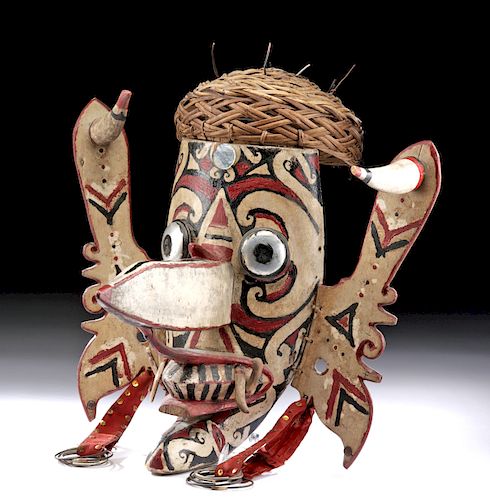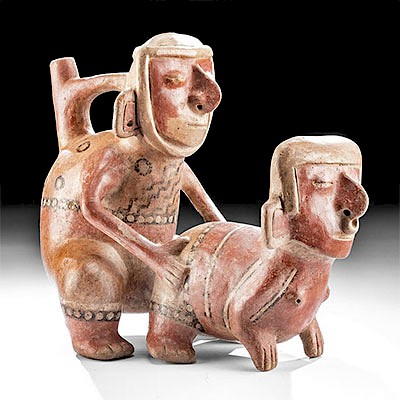Early 20th C. Borneo Bahau Dayak Wooden Hudoq Mask
Lot 105
About Seller
Artemis Fine Arts
686 S Taylor Ave, Ste 106
Louisville, CO 80027
United States
Selling antiquities, ancient and ethnographic art online since 1993, Artemis Gallery specializes in Classical Antiquities (Egyptian, Greek, Roman, Near Eastern), Asian, Pre-Columbian, African / Tribal / Oceanographic art. Our extensive inventory includes pottery, stone, metal, wood, glass and textil...Read more
Estimate:
$800 - $1,200
Absentee vs Live bid
Two ways to bid:
- Leave a max absentee bid and the platform will bid on your behalf up to your maximum bid during the live auction.
- Bid live during the auction and your bids will be submitted real-time to the auctioneer.
Bid Increments
| Price | Bid Increment |
|---|---|
| $0 | $25 |
| $300 | $50 |
| $1,000 | $100 |
| $2,000 | $250 |
| $5,000 | $500 |
| $10,000 | $1,000 |
| $20,000 | $2,500 |
| $50,000 | $5,000 |
| $100,000 | $10,000 |
| $200,000 | $20,000 |
About Auction
By Artemis Fine Arts
Jan 30, 2020
Set Reminder
2020-01-30 10:00:00
2020-01-30 10:00:00
America/New_York
Bidsquare
Bidsquare : Pre-Columbian | Tribal | Ethnographic
https://www.bidsquare.com/auctions/artemis-gallery/pre-columbian-tribal-ethnographic-4830
Featuring ancient and ethnographic art from around the world, including Pre-Columbian, Native American, African / Tribal, Oceanic, Ethnographic, Spanish Colonial, Fossils, Fine Art, much more. Artemis Fine Arts info@artemisfinearts.com
Featuring ancient and ethnographic art from around the world, including Pre-Columbian, Native American, African / Tribal, Oceanic, Ethnographic, Spanish Colonial, Fossils, Fine Art, much more. Artemis Fine Arts info@artemisfinearts.com
- Lot Description
Southeast Asia, Indonesia, Borneo, East/Central Kalimantan, Mahakam River, Dayak peoples, Bahau group, ca. first half of the 20th century CE. A wondrous example of a wooden festival mask constructed from several hand-carved wooden components. This style of mask is known as a hudoq ("hornbill bird"), though hudoq is also a style of mask representing one of thirteen different crop-destroying pests such as rats, lions, birds, and insects. The ovoid mask has petite eye holes beneath painted metal eye caps, an enormous nose, a broad mouth lined with painted teeth and four protruding fangs, an elongated chin, articulated ear flaps with projecting upper 'horns' and suspended metal rings below, all beneath a woven rattan fiber cap. The cream-ground mask is accentuated with broad streaks of black, red, and white pigment that imbue it with a fantastical sense of movement and character. Size: 16.1" W x 16.25" H (40.9 cm x 41.3 cm).
For a strikingly similar example from the Kayanic Dayak people, please see The Metropolitan Museum of Art, accession number 1988.143.77.
Provenance: private Nevada, USA collection, collected in the field near the upper Mahakan River
All items legal to buy/sell under U.S. Statute covering cultural patrimony Code 2600, CHAPTER 14, and are guaranteed to be as described or your money back.
A Certificate of Authenticity will accompany all winning bids.
We ship worldwide and handle all shipping in-house for your convenience.
#152288Repair to one ear panel with small chips and light adhesive residue along break lines. Minor abrasions to mask, ear panels, peripheries, and verso, with fading to original pigmentation and light touch-up painting to some areas, and some weathering to glass medallion on forehead. Great traces of original pigmentation throughout.Condition
- Shipping Info
-
All shipping is handled in-house for your convenience. Your invoice from Artemis Gallery will include shipping calculation instructions. If in doubt, please inquire BEFORE bidding for estimated shipping costs for individual items.
-
- Buyer's Premium



 EUR
EUR CAD
CAD AUD
AUD GBP
GBP MXN
MXN HKD
HKD CNY
CNY MYR
MYR SEK
SEK SGD
SGD CHF
CHF THB
THB














